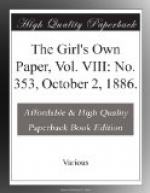the greater the effect produced, while the colouring
should be of a vivid tone, but excluding the bright
aniline dyes already once referred to as being unsuitable
to blend with other shades. A strong piece of
ticking is required for the foundation, and on this
the pieces are arranged. They should be pinned
on while the amalgamation of colouring is being tried,
and, when that is settled, basted on to the lining,
the edges of soft materials being turned under and
secured with the basting lines. Similarity in
shape and size is to be avoided when placing the pieces,
and the effect aimed at that of the colouring of a
kaleidoscope in its variety and brightness. In
order to obtain queer shapes and corners, it is not
necessary to carefully cut them out and fit them into
their various spaces; in fact, it is better not to
do so, but to lay one material partly over another,
and by so doing make the desired form. The embroidery
is generally left until the pieces are basted down
to the lining, but now and again the scraps should
be embroidered before they are fixed down, this method
being the least troublesome when fine silk work is
attempted, such as working flowers in shades of colour
or intricate designs, or following out the lines of
stamped velvet or brocade with couched-down cords
and gold thread. Thin Oriental silks require
a thin muslin lining underneath them, and the embroidery
executed before they are tacked to the ticking, as
unless this precaution is taken they are apt to pucker
and look uneven and poor. When the patchwork
scraps are all arranged, spare strands of filoselle
of any shades are used to cover over the basting threads
with lines of coral stitch, feather, chain, rope,
and herringbone, while oddments of silk cord, Japanese
gold thread, very fine braids, etc., are sewn
down either as borderings to the securing lines or
as forming designs and figures on the patches themselves.
Embroidery stitches of all kinds are used to fill
in the centres of the patches, and advantage is always
taken of any pattern on the patches either by filling
it in entirely with shaded silks, filling up its background
with stars, crosses, or dots, or by enclosing it within
diagonal lines, or sewing spangles down so as to cover
it over. Every effort is made to enrich the patches
by the use of gold thread, spangles, gold lace, and
silk cords, and when the work is faithfully done,
no one could guess it was devised out of oddments
and produced at a nominal cost.
B. C. SAWARD.
ROMANCE.
FOR VIOLIN AND PIANOFORTE.
PROFESSOR SIR G. A. MACFARREN.
[Music]
ANSWERS TO CORRESPONDENTS.
EDUCATIONAL.




